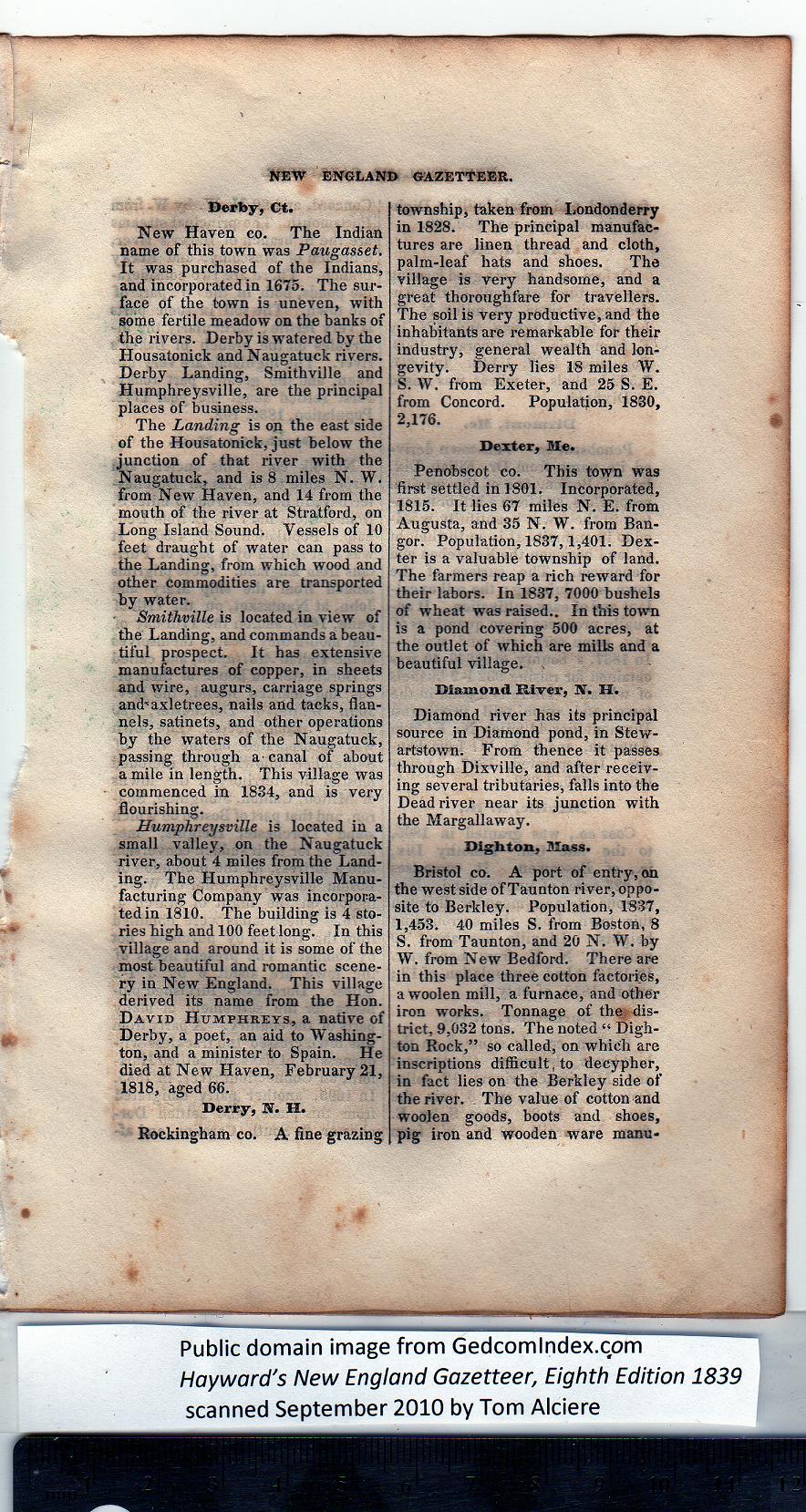|
Derby, Ct.
New Haven co. The Indian
name of this town was Paugasset.
It was purchased of the Indians,
and incorporated in 1675. The sur-
face of the town is uneven, with
some fertile meadow on the banks of
the rivers. Derby is watered by the
Housatonick and Naugatuck rivers.
Derby Landing, Smithville and
Humphreysville, are the principal
places of business.
The Landing is on the east side
of the Housatonick, just below the
junction of that river with the
Naugatuck, and is 8 miles N. W.
from New Haven, and 14 from the
mouth of the river at Stratford, on
Long Island Sound. Vessels of 10
feet draught of water can pass to
the Landing, from which wood and
other commodities are transported
by water.
Smithville is located in view of
the Landing, and commands a beau-
tiful prospect. It has extensive
manufactures of copper, in sheets
and wire, augurs, carriage springs
and^axletrees, nails and tacks, flan-
nels, satinets, and other operations
hy the waters of the Naugatuck,
passing through a-canal of about
a mile in length. This village was
commenced in 1834, and is very
flourishing.
Humphreysville is located in a
small valley, on the Naugatuck
river, about 4 miles from the Land-:
ing. The Humphreysville Manu-
facturing Company was incorpora-
ted in 1810. The building is 4 sto-
ries high and 100 feet long. In this
village and around it is some of the
most beautiful and romantic scene-
ry in New England. This village
derived its name from the Hon.
David Humphreys, a native of
Derby, a poet, an aid to Washing-
ton, and a minister to Spain. He
died at New Haven, February 21,
1818, aged 66.
Derry, Iff. H. |
Rockingham co. A fine grazing
township, taken from Londonderry
in 1828. The principal manufac-
tures are linen thread and cloth,
palm-leaf hats and shoes. The
village is very handsome, and a
great thoroughfare for travellers.
The soil is very productive, and the
inhabitants are remarkable for their
industry, general wealth and lon-
gevity. Derry lies 18 miles W.
S. W. from Exeter, and 25 S. E.
from Concord. Population, 1830,
2,176.
Dexter, Me.
Penobscot co. This town was
first settled in 1801. Incorporated,
1815. It lies 67 miles N. E. from
Augusta, and 35 N. W. from Ban-
gor. Population, 1837,1,401. Dex-
ter is a valuable township of land.
The farmers reap a rich reward for
their labors. In 1837, 7000 bushels
of wheat was raised.. In this town
is a pond covering 500 acres, at
the outlet of which are mills and a
beautiful village.
Diamond River, IV. H.
Diamond river has its principal
source in Diamond pond, in Stew-
artstown. From thence it passes
through Dixville, and after receiv-
ing several tributaries, falls into the
Dead river near its junction with
the Margallaway.
Dighton, Mass.
Bristol co. A port of entry, on
the west side of Taunton river, oppo-
site to Berkley. Population, 1837,
1,458. 40 miles S. from Boston, 8
S. from Taunton, and 20 N. W. by
W. from New Bedford. There are
in this place three cotton factories,
a woolen mill, a furnace, and other
iron works. Tonnage of the dis-
trict, 9,032 tons. The noted “ Digh-
ton Rock,” so called, on which are
inscriptions difficult, to decypher,
in fact lies on the Berkley side of
the river. The value of cotton and
woolen goods, hoots and shoes,
pig iron and wooden ware manu- |
